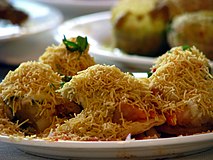 Sev | |
| Course | Snack |
|---|---|
| Place of origin | India |
| Main ingredients | Chickpea flour |
| Variations | Ratlami sev, Indori sev, Gaathiya, Potato sev |
Sev is a popular Indian snack food[1] consisting of small pieces of crunchy noodles made from chickpea flour paste, which are seasoned with turmeric, cayenne, and ajwain[2] before being deep-fried in oil.[3][4][5] These noodles vary in thickness.[6] Ready-to-eat varieties of sev, including flavoured sev, are available in Indian stores.[7]
Sev is eaten as a standalone snack and is also sprinkled as a topping on dishes like bhelpuri and sevpuri. Sev can be made at home and stored for weeks in airtight containers.[7]
Sev is a popular snack in India with several regional variations, particularly for chaat snacks in Uttar Pradesh and Bihar where it is eaten topped with sweetened boondi. The snack is also popular in Madhya Pradesh, especially in the cities of Indore, Ujjain and Ratlam, where many snack foods contain sev as a main ingredient. In Madhya Pradesh, sev is used as a side ingredient in almost every chaat snack food, especially ratlami sev, which is made from cloves and chickpea flour. Many varieties of sev are sold commercially, such as laung (clove in Hindi) sev, tomato sev, palak sev, plain sev, chanachur and bhujia.
Mota sev is a variety of sev which is bigger in size.[8]
Popular varieties of sev mixed with nuts, lentils and pulses are commonly sold as 'Bombay mix' or chanachur.
While mostly known as a snack food or topping, sev can also be a key ingredient in legume curries. The dish Sev Usal is a curry made with onion tomato gravy cooked with boiled dried peas. A handful of crunchy sev is added in the liquid pea stew muck like one add cruncy cereal to liquid milk. [9]
-
Yellow bits of sev on sevpuri
- ^ Raina, Usha (2001). Basic Food Preparation (Third ed.). Orient Blackswan. p. 290. ISBN 8125023003.
- ^ "Crispy Sev Recipe for a Crackling Diwali".
- ^ Gress, Priti Chitnis (2008). Flavorful India: Treasured Recipes from a Gujarati Family. Hippocrene Books. p. 35. ISBN 978-0-7818-1207-8.
- ^ Brennan, Jennifer (1984). The cuisines of Asia: nine great oriental cuisines by technique. St. Martin's/Marek. pp. 26. ISBN 0-312-66116-9.
- ^ King, Niloufer Ichaporia (2007). My Bombay kitchen: traditional and modern Parsi home cooking. University of California Press. p. 311. ISBN 978-0-520-24960-8.
- ^ Aruna Thaker, Arlene Barton (2012). Multicultural Handbook of Food, Nutrition and Dietetics. John Wiley & Sons. p. 17. ISBN 978-1-4051-7358-2.
- ^ a b Doshi, Malvi (2002). Cooking Along the Ganges: The Vegetarian Heritage of India. iUniverse. p. 174. ISBN 0-595-24422-X.
- ^ "Snack Food Association demands 5 percent GST rate instead of 12 percent on Namkeen-farsans". 21 June 2017.
- ^ Pankti (2020-01-03). "Sev Usal". life extraordinaire!. Retrieved 2024-07-15.
